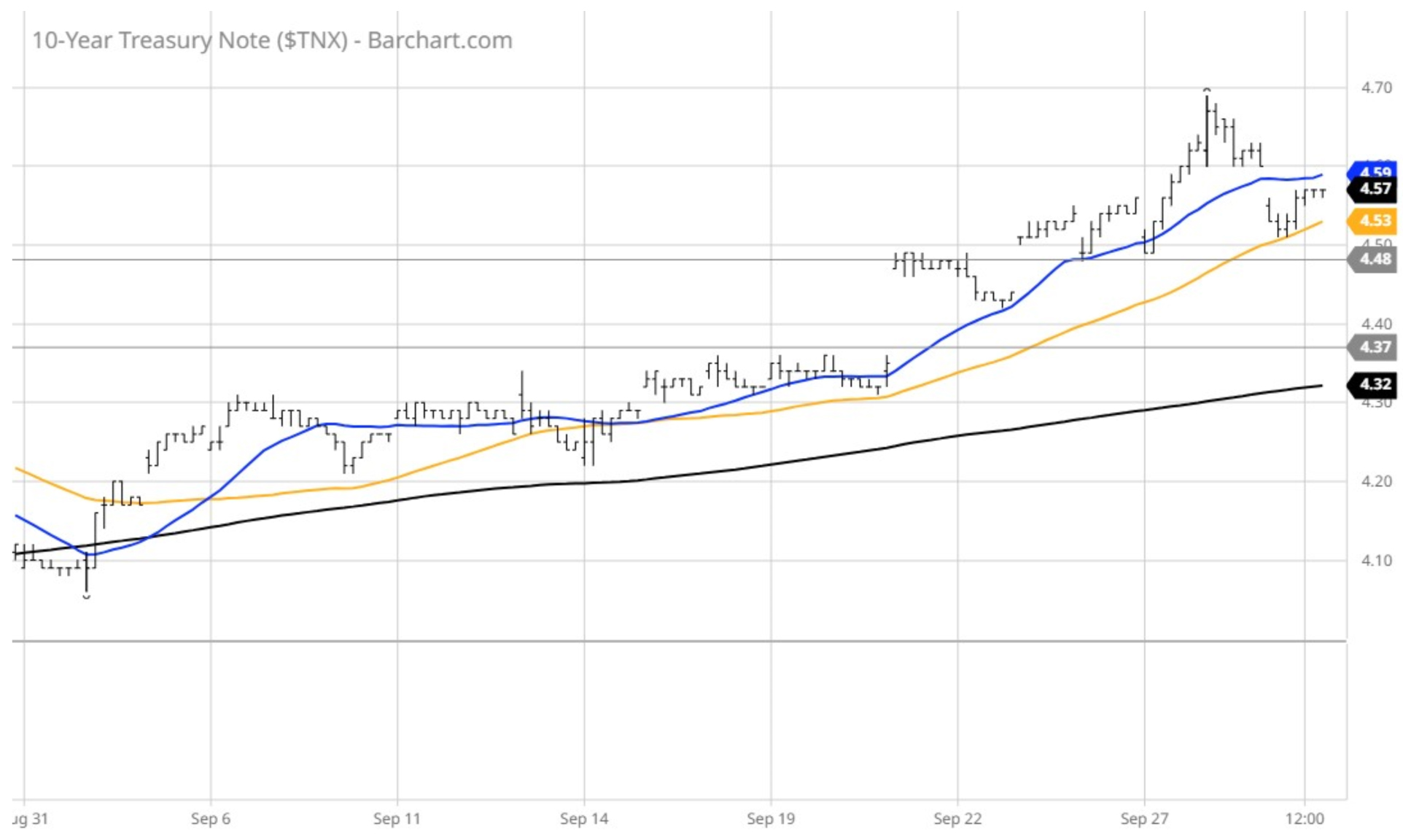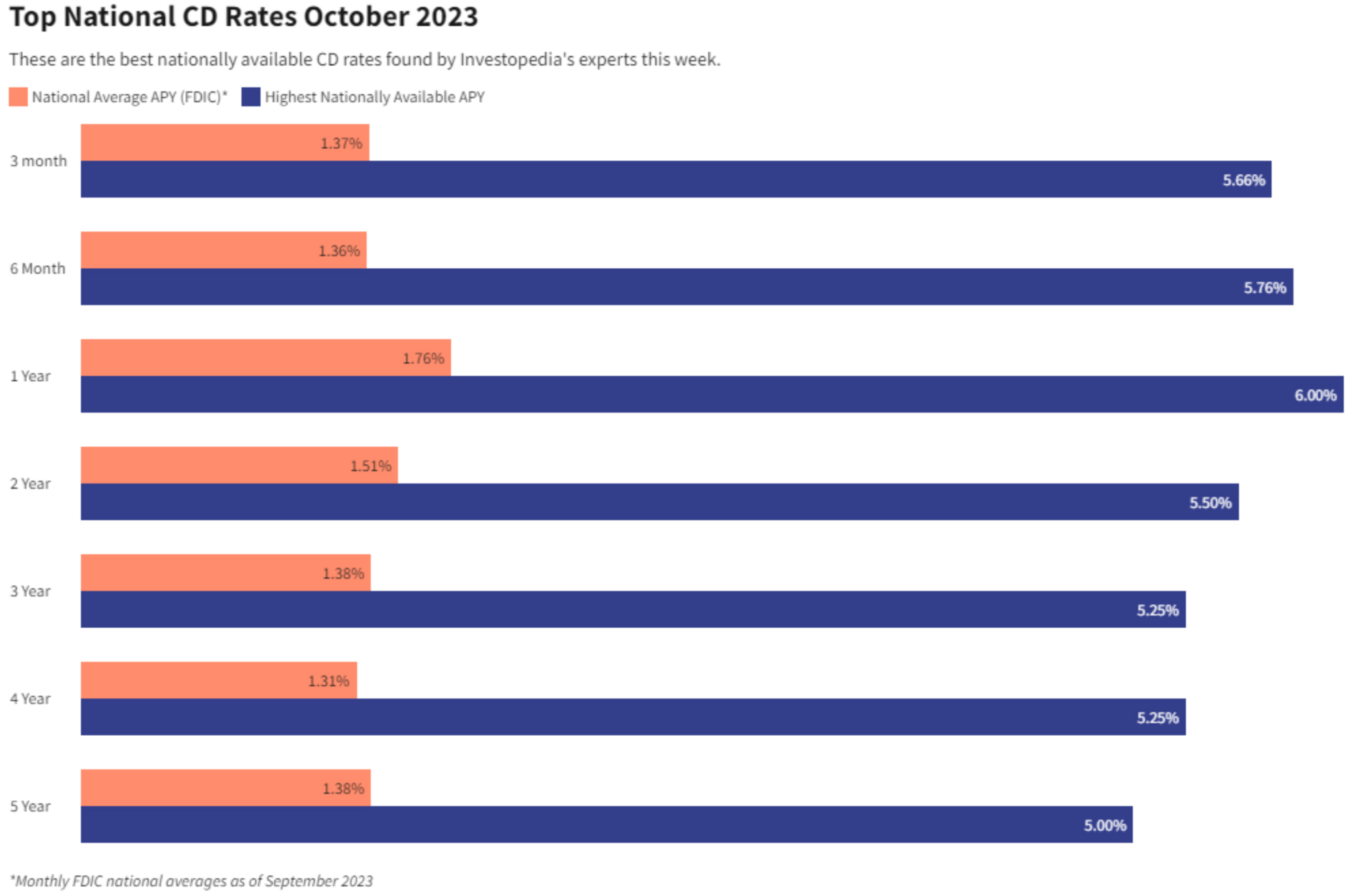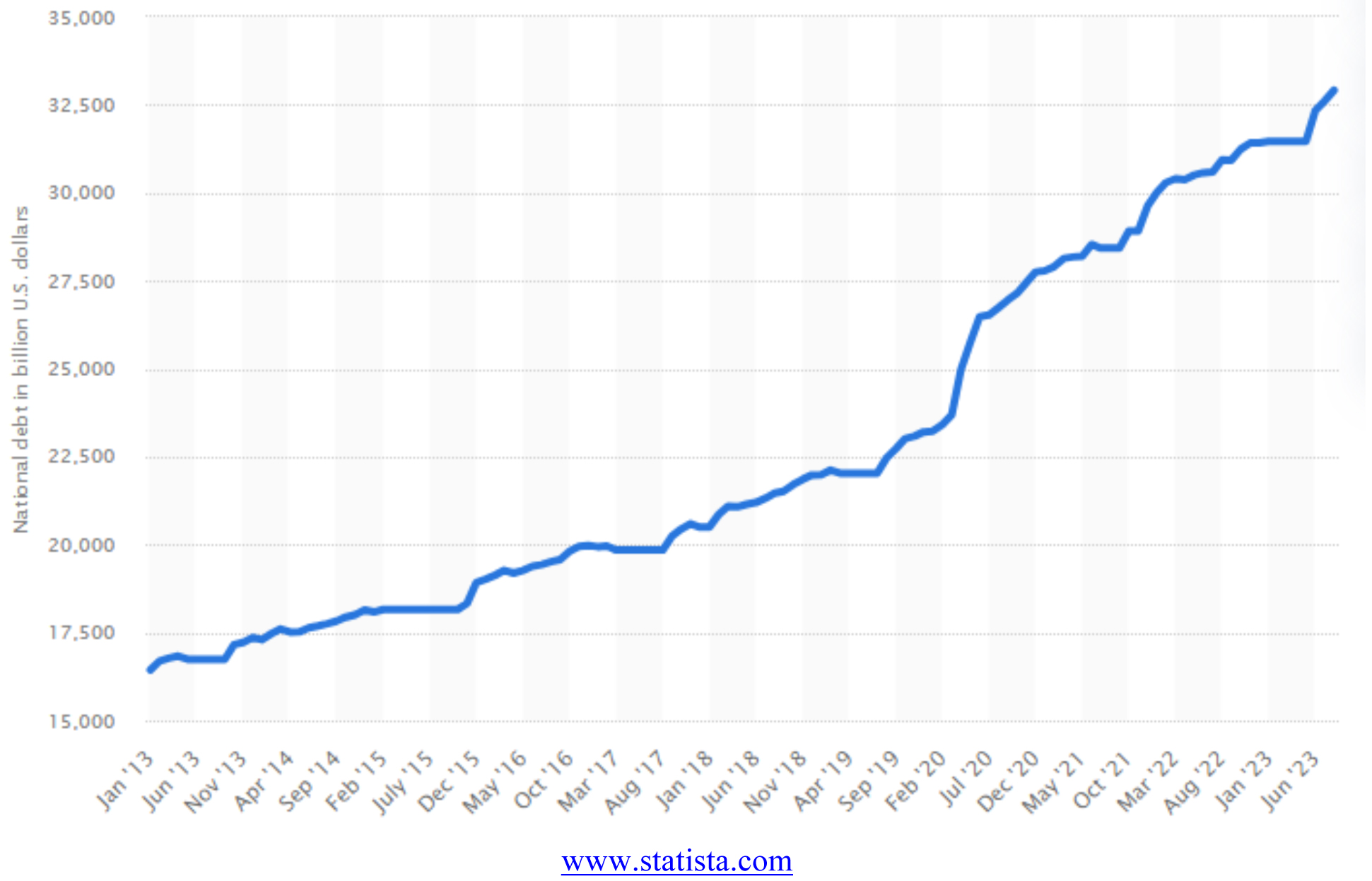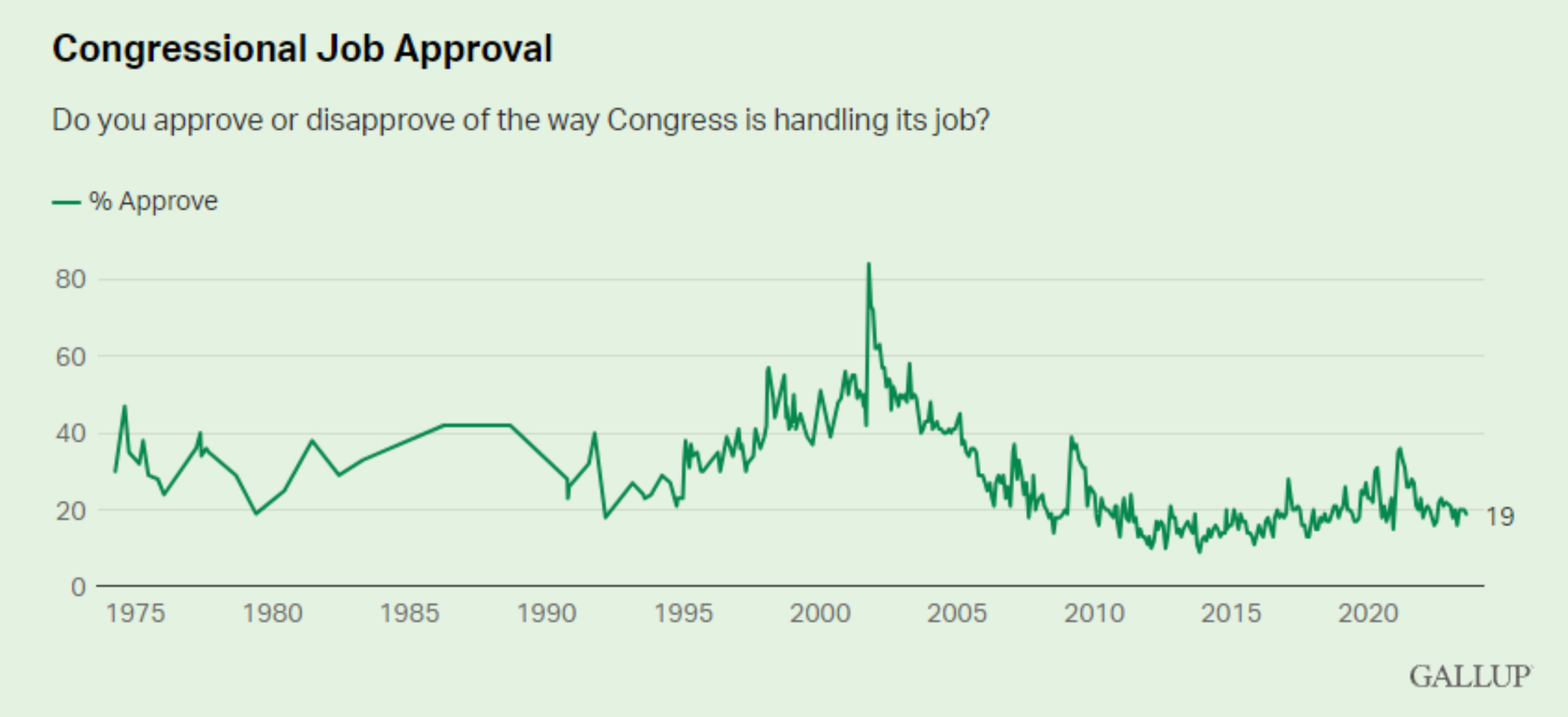by Bryan Perry
October 3, 2023
For Wall Street professionals and private investors alike, last weekend marked “good riddance” to the month of September, where broad selling pressure weighed on both stocks and bonds. It was a time to be long oil and oil-related stocks, floating-rate debt, and the U.S. dollar. Not much else was working.
Hopefully, October and the ushering in of third-quarter earnings season will help to shift sentiment into a more bullish tone, but there are some large unresolved issues that could keep the market on the defensive.
At the top of the list of ongoing concerns is Fed monetary policy, specifically the recent change in the Fed’s outlook for the next year. The market had been expecting the Fed to leave rates unchanged at current levels, through May-July 2024, and then begin to reduce the Fed Funds rate by 100 basis points by January 1, 2025. After the September 20 meeting, the market now believes the Fed will hold rates where they are for longer, and maybe have room for cuts of up to 50 basis points by the back-end of next year.
This sudden shift in thinking unglued the bond market, sending yields on the benchmark 10-year Treasury Bond from 4.37% to nearly 4.70% in the span of just a few days and put the kibosh on any notion of a bullish window-dressing quarter-ending rally. That, and seeing WTI crude oil briefly trade up to $95 per barrel raised the specter of a hot read from the Personal Consumption Expenditures (PCE) index released last Friday. True, it did reflect higher food and energy prices on the headline number of 0.4%, but it also showed core inflation (ex-food and energy) trending still lower for August, with a net gain of only 0.1%.

Graphs are for illustrative and discussion purposes only. Please read important disclosures at the end of this commentary.
As of Sunday October 1, the closely monitored CME Fed Watch Tool showed an 81.7% probability of the Fed keeping the Fed Funds rate at 5.25%-5.50% at the November 1 FOMC meeting and a 64.8% probability of no rate hike for the last FOMC meeting, scheduled for December 13. At the same time, Citigroup CEO Jane Fraser said that she expected the Federal Reserve to raise interest rates in November but hopes there is no need for another hike. I believe her comment is simply out of touch with reality.
The Fed Watch Tool uses the prices of fed funds futures, contracts on the CME to project the real-time probability of federal funds rate changes. The Fed Watch Tool implies that the Fed is done with rate hikes. But that doesn’t guarantee lower bond yields are on the horizon. At the CNBC Delivering Alpha Investor Summit, hedge fund manager Bill Ackman was again “talking his book,” where he is short Treasuries via options, so as to avoid paying interest on being short the physical bonds. “I would not be shocked to see 30-year rates through the 5% barrier, and you could see the 10-year approach 5%.”
At the same conference, hedge fund manager David Tepper said, “It’s not complicated right now. You’re just not in QE (easing) times anymore. You’re in the QT (tightening) era. It’s a higher rate environment. Can’t be the same multiples as before. It’s not bad. It’s just different.” Tepper noted that he hasn’t sold anything in his portfolio, and includes five of the Magnificent Seven stocks as top portfolio holdings. (Interestingly, his latest trade was buying a 6-month CD, paying 6.0%.)

Graphs are for illustrative and discussion purposes only. Please read important disclosures at the end of this commentary.
Oddly enough, the relief from Friday’s rather tame inflation report lasted all of about one hour. The market opened Friday only to see selling pressure return as reports of an expanded auto strike and a possible government shutdown crossed the tape. Congress avoided the shutdown by finally passing a short-term spending bill on Saturday that expires in 45 days, but both parties remain widely divided on appropriations for Ukraine, border security and how to deal with the national debt, now at $33 trillion.
Ray Dalio, the founder of hedge fund Bridgewater Associates, stated in an interview with CNBC’s Sara Eisen, aired last Thursday, “We’re going to have a debt crisis in this country.” Their fireside chat at the Managed Funds Association continued when Dalio said, “How fast it transpires, I think, is going to be a function of that supply-demand issue, so I’m watching that very closely.”

Graphs are for illustrative and discussion purposes only. Please read important disclosures at the end of this commentary.
The whole world is watching how our leaders address this rising debt problem. What they are watching is the Fed trying to shrink their $8.7 trillion balance sheet while Congress passes huge spending bills, lifting the debt ceiling on a constant basis. They are watching soaring lawlessness in some of America’s largest cities. They are watching a crisis at the southern border, a failing energy policy and major dysfunctions within Congress, reflecting a vacuum of leadership. Only 19% of Americans approve of the job Congress is doing, with 82% supporting term limits, including 89% of Republicans and 76% of Democrats.

Graphs are for illustrative and discussion purposes only. Please read important disclosures at the end of this commentary.
My point here is that while the Fed may be focusing on getting the rate of inflation down toward their 2% target, that doesn’t necessarily mean that Treasury yields across the longer end of the curve will come down in tandem with any Fed Funds rate cuts the Fed may make next year. The Fed could lose control of the long end of the curve if buyers of Treasuries demand a higher return to compensate for the risk of a soaring debt-to-GDP ratio, excessive spending, possible government shutdowns and culture wars.
At some point, probably sooner than later, our elected officials on Capitol Hill must deal with getting our fiscal and social houses in order, or those record bond auctions being held every week won’t go so well.
All content above represents the opinion of Bryan Perry of Navellier & Associates, Inc.
Also In This Issue
A Look Ahead by Louis Navellier
Crude Oil Prices Reach a 13-Month High
Income Mail by Bryan Perry
Lower Inflation May Not Mean Lower Treasury Yields
Growth Mail by Gary Alexander
The Fourth Quarter Explosion is About to Start
Global Mail by Ivan Martchev
The Selloff in Stocks is the Fed’s Fault
Sector Spotlight by Jason Bodner
October – the Good News and the Bad News
View Full Archive
Read Past Issues Here

Bryan Perry
SENIOR DIRECTOR
Bryan Perry is a Senior Director with Navellier Private Client Group, advising and facilitating high net worth investors in the pursuit of their financial goals.
Bryan’s financial services career spanning the past three decades includes over 20 years of wealth management experience with Wall Street firms that include Bear Stearns, Lehman Brothers and Paine Webber, working with both retail and institutional clients. Bryan earned a B.A. in Political Science from Virginia Polytechnic Institute & State University and currently holds a Series 65 license. All content of “Income Mail” represents the opinion of Bryan Perry
Important Disclosures:
Although information in these reports has been obtained from and is based upon sources that Navellier believes to be reliable, Navellier does not guarantee its accuracy and it may be incomplete or condensed. All opinions and estimates constitute Navellier’s judgment as of the date the report was created and are subject to change without notice. These reports are for informational purposes only and are not a solicitation for the purchase or sale of a security. Any decision to purchase securities mentioned in these reports must take into account existing public information on such securities or any registered prospectus.To the extent permitted by law, neither Navellier & Associates, Inc., nor any of its affiliates, agents, or service providers assumes any liability or responsibility nor owes any duty of care for any consequences of any person acting or refraining to act in reliance on the information contained in this communication or for any decision based on it.
Past performance is no indication of future results. Investment in securities involves significant risk and has the potential for partial or complete loss of funds invested. It should not be assumed that any securities recommendations made by Navellier. in the future will be profitable or equal the performance of securities made in this report. Dividend payments are not guaranteed. The amount of a dividend payment, if any, can vary over time and issuers may reduce dividends paid on securities in the event of a recession or adverse event affecting a specific industry or issuer.
None of the stock information, data, and company information presented herein constitutes a recommendation by Navellier or a solicitation to buy or sell any securities. Any specific securities identified and described do not represent all of the securities purchased, sold, or recommended for advisory clients. The holdings identified do not represent all of the securities purchased, sold, or recommended for advisory clients and the reader should not assume that investments in the securities identified and discussed were or will be profitable.
Information presented is general information that does not take into account your individual circumstances, financial situation, or needs, nor does it present a personalized recommendation to you. Individual stocks presented may not be suitable for every investor. Investment in securities involves significant risk and has the potential for partial or complete loss of funds invested. Investment in fixed income securities has the potential for the investment return and principal value of an investment to fluctuate so that an investor’s holdings, when redeemed, may be worth less than their original cost.
One cannot invest directly in an index. Index is unmanaged and index performance does not reflect deduction of fees, expenses, or taxes. Presentation of Index data does not reflect a belief by Navellier that any stock index constitutes an investment alternative to any Navellier equity strategy or is necessarily comparable to such strategies. Among the most important differences between the Indices and Navellier strategies are that the Navellier equity strategies may (1) incur material management fees, (2) concentrate its investments in relatively few stocks, industries, or sectors, (3) have significantly greater trading activity and related costs, and (4) be significantly more or less volatile than the Indices.
ETF Risk: We may invest in exchange traded funds (“ETFs”) and some of our investment strategies are generally fully invested in ETFs. Like traditional mutual funds, ETFs charge asset-based fees, but they generally do not charge initial sales charges or redemption fees and investors typically pay only customary brokerage fees to buy and sell ETF shares. The fees and costs charged by ETFs held in client accounts will not be deducted from the compensation the client pays Navellier. ETF prices can fluctuate up or down, and a client account could lose money investing in an ETF if the prices of the securities owned by the ETF go down. ETFs are subject to additional risks:
- ETF shares may trade above or below their net asset value;
- An active trading market for an ETF’s shares may not develop or be maintained;
- The value of an ETF may be more volatile than the underlying portfolio of securities the ETF is designed to track;
- The cost of owning shares of the ETF may exceed those a client would incur by directly investing in the underlying securities; and
- Trading of an ETF’s shares may be halted if the listing exchange’s officials deem it appropriate, the shares are delisted from the exchange, or the activation of market-wide “circuit breakers” (which are tied to large decreases in stock prices) halts stock trading generally.
Grader Disclosures: Investment in equity strategies involves substantial risk and has the potential for partial or complete loss of funds invested. The sample portfolio and any accompanying charts are for informational purposes only and are not to be construed as a solicitation to buy or sell any financial instrument and should not be relied upon as the sole factor in an investment making decision. As a matter of normal and important disclosures to you, as a potential investor, please consider the following: The performance presented is not based on any actual securities trading, portfolio, or accounts, and the reported performance of the A, B, C, D, and F portfolios (collectively the “model portfolios”) should be considered mere “paper” or pro forma performance results based on Navellier’s research.
Investors evaluating any of Navellier & Associates, Inc.’s, (or its affiliates’) Investment Products must not use any information presented here, including the performance figures of the model portfolios, in their evaluation of any Navellier Investment Products. Navellier Investment Products include the firm’s mutual funds and managed accounts. The model portfolios, charts, and other information presented do not represent actual funded trades and are not actual funded portfolios. There are material differences between Navellier Investment Products’ portfolios and the model portfolios, research, and performance figures presented here. The model portfolios and the research results (1) may contain stocks or ETFs that are illiquid and difficult to trade; (2) may contain stock or ETF holdings materially different from actual funded Navellier Investment Product portfolios; (3) include the reinvestment of all dividends and other earnings, estimated trading costs, commissions, or management fees; and, (4) may not reflect prices obtained in an actual funded Navellier Investment Product portfolio. For these and other reasons, the reported performances of model portfolios do not reflect the performance results of Navellier’s actually funded and traded Investment Products. In most cases, Navellier’s Investment Products have materially lower performance results than the performances of the model portfolios presented.
This report contains statements that are, or may be considered to be, forward-looking statements. All statements that are not historical facts, including statements about our beliefs or expectations, are “forward-looking statements” within the meaning of The U.S. Private Securities Litigation Reform Act of 1995. These statements may be identified by such forward-looking terminology as “expect,” “estimate,” “plan,” “intend,” “believe,” “anticipate,” “may,” “will,” “should,” “could,” “continue,” “project,” or similar statements or variations of such terms. Our forward-looking statements are based on a series of expectations, assumptions, and projections, are not guarantees of future results or performance, and involve substantial risks and uncertainty as described in Form ADV Part 2A of our filing with the Securities and Exchange Commission (SEC), which is available at www.adviserinfo.sec.gov or by requesting a copy by emailing info@navellier.com. All of our forward-looking statements are as of the date of this report only. We can give no assurance that such expectations or forward-looking statements will prove to be correct. Actual results may differ materially. You are urged to carefully consider all such factors.
FEDERAL TAX ADVICE DISCLAIMER: As required by U.S. Treasury Regulations, you are informed that, to the extent this presentation includes any federal tax advice, the presentation is not written by Navellier to be used, and cannot be used, for the purpose of avoiding federal tax penalties. Navellier does not advise on any income tax requirements or issues. Use of any information presented by Navellier is for general information only and does not represent tax advice either express or implied. You are encouraged to seek professional tax advice for income tax questions and assistance.
IMPORTANT NEWSLETTER DISCLOSURE:The hypothetical performance results for investment newsletters that are authored or edited by Louis Navellier, including Louis Navellier’s Growth Investor, Louis Navellier’s Breakthrough Stocks, Louis Navellier’s Accelerated Profits, and Louis Navellier’s Platinum Club, are not based on any actual securities trading, portfolio, or accounts, and the newsletters’ reported hypothetical performances should be considered mere “paper” or proforma hypothetical performance results and are not actual performance of real world trades. Navellier & Associates, Inc. does not have any relation to or affiliation with the owner of these newsletters. There are material differences between Navellier Investment Products’ portfolios and the InvestorPlace Media, LLC newsletter portfolios authored by Louis Navellier. The InvestorPlace Media, LLC newsletters contain hypothetical performance that do not include transaction costs, advisory fees, or other fees a client might incur if actual investments and trades were being made by an investor. As a result, newsletter performance should not be used to evaluate Navellier Investment services which are separate and different from the newsletters. The owner of the newsletters is InvestorPlace Media, LLC and any questions concerning the newsletters, including any newsletter advertising or hypothetical Newsletter performance claims, (which are calculated solely by Investor Place Media and not Navellier) should be referred to InvestorPlace Media, LLC at (800) 718-8289.
Please note that Navellier & Associates and the Navellier Private Client Group are managed completely independent of the newsletters owned and published by InvestorPlace Media, LLC and written and edited by Louis Navellier, and investment performance of the newsletters should in no way be considered indicative of potential future investment performance for any Navellier & Associates separately managed account portfolio. Potential investors should consult with their financial advisor before investing in any Navellier Investment Product.
Navellier claims compliance with Global Investment Performance Standards (GIPS). To receive a complete list and descriptions of Navellier’s composites and/or a presentation that adheres to the GIPS standards, please contact Navellier or click here. It should not be assumed that any securities recommendations made by Navellier & Associates, Inc. in the future will be profitable or equal the performance of securities made in this report.
FactSet Disclosure: Navellier does not independently calculate the statistical information included in the attached report. The calculation and the information are provided by FactSet, a company not related to Navellier. Although information contained in the report has been obtained from FactSet and is based on sources Navellier believes to be reliable, Navellier does not guarantee its accuracy, and it may be incomplete or condensed. The report and the related FactSet sourced information are provided on an “as is” basis. The user assumes the entire risk of any use made of this information. Investors should consider the report as only a single factor in making their investment decision. The report is for informational purposes only and is not intended as an offer or solicitation for the purchase or sale of a security. FactSet sourced information is the exclusive property of FactSet. Without prior written permission of FactSet, this information may not be reproduced, disseminated or used to create any financial products. All indices are unmanaged and performance of the indices include reinvestment of dividends and interest income, unless otherwise noted, are not illustrative of any particular investment and an investment cannot be made in any index. Past performance is no guarantee of future results.
